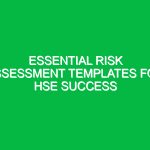Introduction
In the realm of Health, Safety, and Environment (HSE) management, the concept of a risk matrix template plays a crucial role. A risk matrix is a visual tool that helps organizations identify, evaluate, and prioritize risks associated with their operations. By providing a structured approach to risk assessment, it enables decision-makers to allocate resources effectively to mitigate potential hazards. Understanding how to implement a risk matrix template is essential for any organization committed to maintaining a safe and compliant working environment.
The relevance of a risk matrix template in HSE management cannot be overstated. Every day, companies face various risks that could impact employee safety, environmental integrity, and operational efficiency. A well-designed risk matrix template serves as a foundational element of a comprehensive risk management strategy. It not only assists in identifying risks but also helps in communicating those risks to all stakeholders involved, ensuring that everyone is aware and prepared to manage them.
Key Concepts of a Risk Matrix Template
To fully appreciate the significance of a risk matrix template, it is important to understand its components and how they function together.
1. Definition of Risk
Risk is defined as the combination of the likelihood of a hazardous event occurring and the consequences of that event. In the HSE context, risks can be associated with chemical exposure, machinery operation, environmental spills, and more. Understanding this definition is the first step in creating an effective risk matrix.
2. Likelihood and Consequence
The risk matrix typically features two axes: likelihood (the probability of a risk occurring) and consequence (the impact if the risk does occur).
– **Likelihood** is often categorized using a scale, such as:
– Rare (1)
– Unlikely (2)
– Possible (3)
– Likely (4)
– Almost Certain (5)
– **Consequence** can also be rated on a scale, including:
– Insignificant (1)
– Minor (2)
– Moderate (3)
– Major (4)
– Catastrophic (5)
The intersection of these two axes provides a risk rating that helps organizations prioritize their focus on the highest risks.
3. Risk Rating Matrix
The risk matrix itself is often represented as a grid. Each cell within the grid corresponds to the combination of likelihood and consequence ratings, resulting in a risk score. For example:
- Low Risk (Green): 1-4
- Moderate Risk (Yellow): 5-9
- High Risk (Orange): 10-14
- Severe Risk (Red): 15-25
This color-coded system allows organizations to quickly assess which risks require immediate attention.
Benefits of Using a Risk Matrix Template
The implementation of a risk matrix template offers several advantages for HSE management:
1. Simplified Risk Assessment
A risk matrix template provides a straightforward visual representation of risks, simplifying the risk assessment process. Stakeholders can easily see where the most significant threats lie and make informed decisions about where to focus their efforts.
2. Enhanced Communication
By standardizing the way risks are evaluated and presented, a risk matrix template fosters better communication among team members. Everyone from management to frontline workers can understand the risks and their implications, leading to more collaborative safety efforts.
3. Prioritization of Resources
With a risk matrix template, organizations can prioritize their resources effectively. By focusing on high-risk areas, they can allocate time, manpower, and budget where it is most needed.
4. Compliance with Regulations
Many industries are governed by strict regulations concerning health, safety, and environmental practices. Utilizing a risk matrix template helps organizations stay compliant by systematically identifying and addressing risks as part of their operational protocols.
Best Practices for Implementing a Risk Matrix Template
For organizations to reap the full benefits of a risk matrix template, following best practices is essential:
1. Customization
Every organization is unique. Therefore, customizing the risk matrix to reflect specific operational realities is crucial. Factors such as industry, geographical location, and workforce characteristics should all inform the design of the template.
2. Involving Stakeholders
Engaging various stakeholders in the risk assessment process enriches the data collected. Employees at different levels have diverse insights into potential hazards, contributing to a more comprehensive risk evaluation.
3. Regular Reviews
Risk management is an ongoing process. Regularly reviewing and updating the risk matrix ensures that it remains relevant as operations evolve or as new risks emerge. This is particularly important in dynamic environments where changes occur frequently.
4. Training and Awareness
Training employees on how to interpret and use the risk matrix is essential to its success. This training should include how to identify new risks, assess them, and apply the findings in real-world scenarios.
Potential Hazards and Safety Considerations
When constructing a risk matrix template, it is vital to recognize the range of potential hazards that may arise in the workplace. These can include:
- Chemical Hazards: Exposure to toxic substances can occur in manufacturing, laboratories, and other settings.
- Physical Hazards: This includes risks from machinery, falls, and ergonomics.
- Biological Hazards: Situations involving exposure to pathogens or allergens.
- Environmental Hazards: Risks related to waste disposal, emissions, and spills.
Each of these hazards must be evaluated in terms of both likelihood and consequence, ensuring that the risk matrix template provides a comprehensive overview of potential dangers.
Case Study: Implementing a Risk Matrix Template
To illustrate the effectiveness of a risk matrix template, consider a hypothetical manufacturing facility that recently adopted this tool.
Prior to implementation, the facility faced numerous safety incidents, with employees expressing concerns over unreported hazards. The management decided to implement a risk matrix template to formalize their HSE management process.
After gathering input from employees at all levels, they identified several key risks, including exposure to chemical fumes and machinery accidents.
Utilizing the risk matrix template, they assessed each risk based on likelihood and consequence. They discovered that chemical exposure was rated as “Likely” with “Major” consequences, resulting in a high-risk score.
In response, the facility implemented additional ventilation systems, developed standard operating procedures for handling chemicals, and initiated training sessions for employees. Over the next year, the facility reported a significant decrease in incidents related to chemical exposure, demonstrating the effectiveness of the risk matrix template in enhancing safety.
Regulations and Standards Affecting Risk Matrices
Organizations must navigate various regulations and standards that govern risk management in the HSE context. Some of the most significant include:
- OSHA (Occupational Safety and Health Administration) regulations mandate the identification and assessment of workplace hazards.
- ISO 45001 outlines the requirements for occupational health and safety management systems, encouraging the use of risk assessments.
- EPA (Environmental Protection Agency) regulations require organizations to assess environmental risks and implement mitigation measures.
Understanding these regulations is crucial for ensuring that the risk matrix template not only serves organizational needs but also complies with legal requirements.
Conclusion
In summary, the risk matrix template is an invaluable tool for effective HSE management. By providing a structured approach to identifying and assessing risks, it enhances communication, prioritizes resource allocation, and ensures compliance with regulations. The journey toward a safer workplace begins with recognizing potential hazards and applying a risk matrix template to manage them effectively.
Organizations are encouraged to adopt this tool, customize it to their needs, and engage all stakeholders in the process. By doing so, they can create a safer, more sustainable working environment that prioritizes health, safety, and environmental stewardship. The time to act is now—ensure your organization is equipped to tackle risks head-on and foster a culture of safety.


